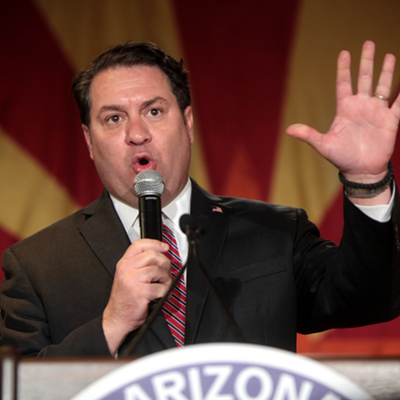Bob has no legal authority to ask for a citywide hike in the gas tax and his office had steadfastly rejected impact fees, so the sales tax is the only vehicle left for him to ride. But if he's not asking growth to pay for itself through impact fees, why should longtime residents agree to carry all of the burden by raising the sales tax?
That niggling question aside, if Bob wants a voter-approved sales-tax hike, he needs to move before the statewide push (which won't be on the ballot before 2003), because there's no way voters will give the city an extra half-cent after giving the state an extra three-quarters-of-a-cent. The city's prop surely won't make the ballot in 2001 (candidates don't want to run on the same ticket as a tax hike, because they'd have to take a stand on it), which leaves four open dates next year. We'd think it would be best on the November ballot, which would likely ensure the highest turnout, but we can see Bob putting it on the ballot in March or May.
We suspect Bob's proposal will split an estimated $40 million a year between building new roads, repairing old roads and expanding public transit. Split three ways, the additional dollars won't go too far in any direction.
And the price will be steep: The city sales tax now sits at 7.6 percent. If voters approve both a half-cent sales tax in the city and three-fourths-of-a-cent statewide, Tucson shoppers will get clipped by 8.85 percent sales tax.
BURCHELL BALLET: Few know Joe Burchell, who has been cracking City Hall for 21 years for the Arizona Daily Star, once showed his skill as a ballet dancer. And in those Tucson Press Club Gridiron Shows, Burchell was not the biggest dancer in a tutu. Though his stage days are over, Burchell is still dancing and his latest was on top of the heads of Mayor Bob Walkup and City Manager James Keene.
Burchell last week single-handedly killed Commander Keene's proposed $6-a-month fee for residential garbage collection. Smilin' Joe pirouetted through a city document that, among Tucson media, only he and one other reporter seem to know about: an audit called the Comprehensive Annual Financial Report. There he found the clear evidence that the city was stashing $29.3 million in a landfill cleanup fund that was started in 1990.
Keene and other city officials have said the fee was the only way to get started on cleaning up, closing and monitoring landfills. The day before Burchell dug through the heap and found the $29 million, Keene had produced propaganda to help sell residents and their dimwitted council members on the tax, which the city tries to hide under the name "environmental fee."
Meanwhile, the Board of Supervisors is itching to jack up Pima County's record budget even higher, bringing it close to $1 billion. And the county's dump department, including money-losing recycling programs, is more than $1.3 million in the red. To make it up, county officials want to charge those who take their own trash to one of three county dumps--Sahuarita, Tangerine and Catalina (transfer station)--$2 per car, $5 per truck, $5 per trailer and $10 for double-axle trailers. Not to be outdone by the city's lies, the county, in an advertisement in the Star/Citizen, claims: "The Solid Waste Division receives no funding from county taxes." The deficit, friends, has indeed been covered by county property tax payers, who--we'll say it again--already suffer from the highest county taxes in Arizona.
Of course, when the Solid Waste budget of $5.5 million was up for review by supervisors two weeks ago, no one asked about some oddities, such as the 60-percent increase in motor pool costs that now will be $1.2 million. The department, which cries that business has been stripped by private landfills, is doing more driving. Why?
ILL SUIT: The University of Arizona has poured nearly $1 million into four law firms to defend the procedures it used, or didn't use, to dismiss one of its once heralded researchers, Marguerite Kay. This stunning waste of money and lawyer-pork was revealed, surprisingly, by the foundering Tucson Citizen. Eric Weslander is to be commended not only for digging out the payola but also for being one of the extremely rare competent reporters at the afternoon rag.
Weslander showed the UA paid $665,947 to Lewis & Roca, the politically connected firm that even employs a member of the Board of Regents, Chris Herstam, as a corporate lobbyist. Herstam is a former state lawmaker and bureaucrat, and pleaded innocent by saying Lewis & Roca brass notified him they were working the case so he abstained from discussion or votes at Regents meetings. You mean Lewis & Roca began work on the Kay defense before the Board of Regents approved their contract?
The UA also paid $133,518 to Phoenix-based Gallagher & Kennedy; $94,721 to Brown & Bain; and $52,797 to the Tucson firm Waterfall, Economidis, Caldwell, Hanshaw & Villamana. Weslander filed state public records requests to get to the money the UA has spent on this nasty four-year battle to get rid of the controversial Alzheimer's researcher. Brown & Bain, which does an excellent job of representing newspapers in Arizona, also represents the Citizen.
Tucson employment law specialist Don Awerkamp has been the Samson fighting the UA Goliath. Still he has scored victories for Kay in what has become a multi-court, multi-layered fight.
Most insulting--more than Lewis & Roca's Herstam connection--was a comment from Janet Bingham, who has defied reason in her rise to UA Vice President for Advancement (her own).
Bingham told Weslander that it was "ridiculous" to assume that taxpayers are paying the UA's legal bills just because the UA is a public institution. "We are smart in the way we allocate and use funds," Bingham told Weslander.
Right. And what is particularly ridiculous is that someone like Bingham, once a lackey to UA spokesmidget Sharon Kha and a rival to Nina Trasoff as a mouthpiece at University Medical Center, takes home $135,200 in annual UA pay. That's more than the UA thinks some of its life-saving cancer docs and researchers are worth. Kha, who also carries around an associate VP title, is paid $97,520 a year. (Those of us who have not yet been paroled from Tucson will remember the preposterous story Kha did for KGUN 19 years ago on Joe Bonanno. We crack up every time we pass the Lucky Wishbone, and specifically the pay phone, on Campbell Avenue.)
Back to the UA legal bills, let's not forget the sizeable "firm" the UA has right on campus. At last check--The Skinny sneaked onto campus for finals week--the UA was spending $792,175 this year for its 10 staff lawyers, led by Judith Leonard and her $135,200. Add on $149,186 for five "legal assistants" and still another $46,159 for "investigator" Joan Kurath. Hey, maybe Joan can develop her own mini-series. Send in your picks for the series name.
When the Board of Regents jacked up tuition to $2,486 a year for in-state students, Herstam and another former Republican state lawmaker, Jack Jewett, joined Judy Gignac in opposing the size--$142--of the increase.
Suddenly a man of the people, Jewett intoned: "I'm very concerned about access, particularly for the underclass that is growing in our state. Unfortunately for many individuals a decision not to enroll in our university is tied to a financial decision or a decision that the student just can't face that kind of debt for student loans."
We agree, Jack. That's why the $1 million in outside legal bills and staff time for the Kay case should have gone to pay tuition for four years for 100 students.







